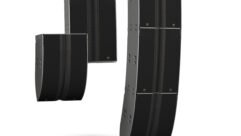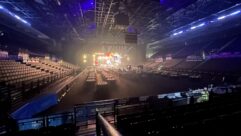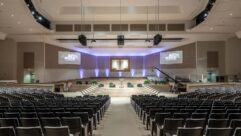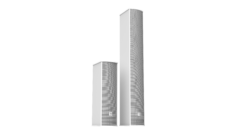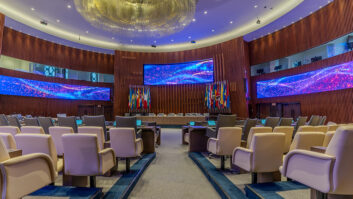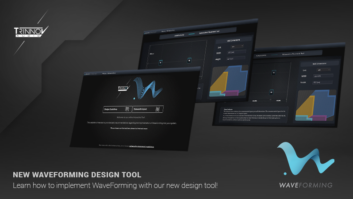
Technology Showcase: Line-array Loudspeakers
May 1, 2008 12:00 PM,
By Bennett Liles
The latest range of enclosures pack more audio punch.

QSC WideLine-8
The field has become quite competitive in the area of line-array loudspeakers. In an effort to gain the edge, companies have introduced a new level of soundscaping through hardware rigging, multi-amplifier control, and software sound-tailoring applications. Smaller enclosures packing more punch are showing up everywhere, and the specs on these systems have reached a new plateau for efficiency and power handling.
From Adamson Systems Engineering, the Metrix is a light, ultra-compact two-way true line-array system. Designed for medium SPL for small to mid-size venues or as an under-hanging side and front or balcony fill in arrays of six or more elements, the Metrix offers two rigging system options. It also incorporates a newly designed Adamson ND8-ML 8.5in. Kevlar neodymium low-mid frequency driver and the B&C DE800 1.4in. high-frequency compression driver with a patented high-frequency wave-shaping chamber. Each enclosure has a 5-degree vertical and 120-degree horizontal coverage pattern.
Alcons Audio offers the LR14, a passive, two-way line-source loudspeaker system as a vertical array either stacked or flown for both touring and permanent installation. The unit features an RBN401 pro-ribbon HF driver, and it is SignalIntegritySensing (SIS) pre-wired for very high damping and reduced distortion. The horizontal dispersion is 120 degrees and the vertical dispersion is 15 degrees with a maximum RMS power-handling capability of 400W and maximum peak power spec of 1000W. For extended bass response, the LR14 can be combined with the pressure-bass LR14B, the deep sub-system BF181, or both.
The 2″×10″ AL10 line-array system from A-Line Acoustics features Line Source Replication for maximum projection and detail, and it uses dual 4-pin or optional 8-pin Speakon connectors for a high-power solution in a small package. The frequency response spec is 75Hz to 18kHz with an 800Hz crossover through 10in. neodymium woofers. The AL10A is available as a powered version and hybrid-active line-array version using the AL10X unpowered slave enclosure. The unit uses XLR connectors — those used by all ICE modules in the A-Line Acoustics product line.
The ALA-9 — the largest of the ALA line-array series from Apogee Sound — is a triamped three-way, electronically coupled system with 1200W LF, 600W MF, and 450W HF response. The unit exhibits a vertical dispersion of 10 degrees and a horizontal dispersion of 90 degrees. The nominal impedance on the low-frequency section is 8Ω and 4Ω on the mid- and high-frequency sections. The ALA-9 provides a maximum SPL of 136dB continuous and 142dB peak. In either a flat-pack or tight-pack configuration, the enclosures are joined together with connecting bars for the desired angular relationship and secured in place by aircraft-grade retention pins.
Technology Showcase: Line-array Loudspeakers
May 1, 2008 12:00 PM,
By Bennett Liles
The latest range of enclosures pack more audio punch.

Apogee Sound ALA-9
For delivering speech intelligibility in a live acoustic environment, Bose offers the Panaray MA12, deployed either singly or in stacked arrays for tight high- and mid-band pattern control. The MA12 reproduces the entire critical vocal range from 155Hz to 112kHz with no crossover required. Depending on the specific type of configuration, the MA12 can be matched in optimum frequency response with the Panaray System Digital Controller for active equalization. The unit has 12 2 1/4in. drivers per enclosure, 300W continuous power handling, and 160-degree horizontal coverage with a maximum acoustic output of 130dB SPL at 3.28ft.
The Q-Series array loudspeakers from d&b audiotechnik are a group of four models using conventional rotatable CD horns, dipolar driver arrangements, and low-compression vented designs with high-excursion drivers and toroidal wave-shaping devices. The Q7 is a passive crossover, two-way enclosure with a 1.3in. exit HF driver and two 10in. LF drivers exhibiting a 75-degree horizontal spread. The 40-degree vertical dispersion angle is maintained down to 400Hz. For extra versatility in mounting applications, the horn can be rotated 90 degrees without removing the metal grille. The various components available from d&b audiotechnik present a wide array of combinations and mounting options.
The Aero-38 externally powered medium-format line-array module from D.A.S. Audio incorporates wide-frequency response in a compact enclosure by integrating low-, mid-, and high-frequency transducers in a single unit. Two 12in. loudspeakers use 4in. voice coils to handle the low end. Two 10in. cones with 3in. voice coils provide the midrange and one ND-10 large-format compression driver pushes the highs. This uses a 4in. titanium diaphragm, copper-clad aluminum EFW voice coil, and a 1.5in. exit throat coupled to a Serpis high-frequency plane-wave generator. This combination allows a frequency range at -10dB points of 50Hz to 18kHz. The horizontal dispersion figure is 90 degrees.
For touring and theatrical applications, Duran Audio offers the Axys Target system with Digital Directivity Synthesis (DDS). At the heart of the system is the Axys Target U-16 line-array module with a vertical slot-diffraction HF horn coupled to a 1in. neodymium compression driver. The self-amplified unit also has two 6.5in. direct radiating low-mid drivers. An internal class AB amplifier provides 530W RMS into 4Ω for the low-mid and 200W RMS into 8Ω for HF performance. The Axys Target U-16 has a total frequency response of 160Hz to 20kHz ±3dB and a 90-degree horizontal dispersion pattern.
Technology Showcase: Line-array Loudspeakers
May 1, 2008 12:00 PM,
By Bennett Liles
The latest range of enclosures pack more audio punch.

Bose Panaray MA12
For small to medium venues at distances up to a little more than 131ft., Dynacord markets the Cobra-2 line-array system to provide a maximum SPL of 137dB in the medium range and up to 141dB in the bass. The Cobra-2 consists of four Cobra-Top mid/high-frequency enclosures, four Cobra-Sub subwoofers, a CSR-12 12RU amp rack, and a 2.5-degree wedge set. The system has a dispersion angle of 120-degrees horizontal and 15-degrees vertical. The Cobra-Sub and Top exhibit 600W RMS power handling at 8Ω.
The NTL720 self-powered, three-way loudspeaker array from EAW has as its most prominent component a single, large MF/HF horn across the face of the enclosure complemented by side-mounted, frequency-shaded LF drivers. Power is provided by three 500W Class-D amplifier modules, each with its own DSP for EQ, delay, and level control. Total acoustic response is 75Hz to 21kHz with a peak SPL of 133dB (127dB continuous) and a 110-degree horizontal by 12-degree vertical dispersion pattern.
The Xlc127+ three-way line-array system from Electro-Voice can be built into an array of four to 16 cabinets, each containing a DL12 low-frequency mid-bass woofer and two 6.5in. horn-loaded drivers in a vertical array for midrange response. The high-frequency section is composed of two ND6 3in. voice-coil neodymium compression drivers loaded on two Hydra plane-wave generators. The Xlc127+ provides a horizontal dispersion pattern of 120 degrees and a vertical angle of 8 degrees with a maximum acoustic SPL of 130dB. The unit may be operated in a biamp or triamp configuration.
Intended for large venues with long-throw requirements, the VLA Series line arrays from JBL offer a tailored solution with a wide range of models. The series provides six large-format horn-loaded modules with three horizontal horn coverage patterns of 30, 60, and 90 degrees. Of these, the VLA901H is a three-way, full-range unit with a response of 58Hz to 12kHz; horizontal coverage of 90 degrees; and maximum sustained sound-pressure levels of 131dB, 139dB, and 142dB for low, mid, and high.
Designed for high performance in a small package, the Arcs from L-Acoustics can be deployed in tightly wrapped arrays in single- or double-row configurations and for horizontal arraying in up to four units. Exhibiting an asymmetrical vertical coverage angle of +40/-20 degrees and a horizontal directivity of 22.5 degrees, the active two-way enclosure uses a single 15in. bass-reflex-loaded loudspeaker with a 3in. voice coil for lows and a 1.4in. compression driver mounted on a DOSC waveguide and lens for HF performance. Four enclosures can deliver 137dB continuous SPL with coverage of 90-degrees horizontal by 50-degrees vertical.
Technology Showcase: Line-array Loudspeakers
May 1, 2008 12:00 PM,
By Bennett Liles
The latest range of enclosures pack more audio punch.

d&b audiotechnik Q7
The Axia from MacPherson is a three-way biamp system optimized for permanent installations. The drivers are aligned to couple with adjacent cabinets, each of which has a 1000W direct-radiating 15in. LF driver, two 8in. twin-coil direct-radiating cone MF drivers, and a 2in. compression driver mounted on a 90-degree by 55-degree slot-CD horn. These produce a total frequency response between -3dB points of 50Hz to 17kHz with a recommended amplifier power of 400W to 600W RMS into 8Ω for the MF/HF section. MacPherson also provides a three-year warranty on the unit.
The new OmniLine from Martin Audio is designed to meet a wide variety of installation scenarios by attaching four to 32 modules for maximum scalability. Each array is specifically tuned by optimization software to meet the specific acoustic profile needed. Each two-way micro-line-array module has an internal impedance of 16V, and they can be wired for assembly into a 4Ω or 8Ω array. The module has a frequency response of 85Hz to 20kHz ± 3dB for a recommended power amp of 100W to 200W. The dispersion of each module is 100-degrees horizontal by5-degrees vertical.
McCauley Sound markets the MLA3 large-scale three-way array for touring applications. The array provides a frequency response of 60Hz to 17kHz at -3dB points, a 90-degree horizontal coverage pattern, and a maximum continuous SPL level of around 130dB. Each enclosure houses twin volumetrically loaded 12in. neodymium cone drivers, twin 8in. HX32 midrange cone drivers, and two HF compression drivers. The low-frequency section has a power-handling capacity of 600W, the midrange 800W, and the HF section 200W.
The latest member of the M Series loudspeakers from Meyer Sound — the M’elodie UltraCompact high-power curvilinear-array loudspeaker — reflects Meyer’s effort in the power-to-size parameter, particularly vital in touring situations. A self-powered three-way system with a 131dB SPL and exhibiting a 100-degree horizontal dispersion, the M’elodie uses QuickFly rigging with captive GuideALinks to simplify flown or ground-stacked arrays. The low/mid section uses 8in. cone drivers with 1.5in. voice coils, while the high frequencies are provided by the same 3in. compression diaphragm used in the larger Mica model.
The Geo S12 Series from Nexo consists of the S1230 and S1210 as the newest additions to the company’s Geo S-Series of tangent-array loudspeakers. The two-way Geo S1230 can be flown horizontally or vertically, or it can be stacked with sub-woofers. The 130dB SPL is provided by a single 12in. driver coupled to a proprietary Directivity Phase Device, and the MF/HF horizontal dispersion pattern is configurable at 80 degrees or 120 degrees. At 16V, the unit is recommended for amplifiers delivering from 500W to 1000W.
Technology Showcase: Line-array Loudspeakers
May 1, 2008 12:00 PM,
By Bennett Liles
The latest range of enclosures pack more audio punch.

JBL VLA901H
The Butterfly C.D.H. 483 Hi-Pack from Outline is the Butterfly system’s component for mid-low, mid, and high-frequency reproduction. The unit gets its name from the distinctive shape of the cabinet, which has triangular openings in the upper and lower sides. The high-frequency section has a 3in. compression driver coupled with a double parabolic reflective waveguide patented by Outline. It also has four 8in. mid woofers, and all the Hi-Pack and Low-Pack units are equipped with flying hardware that enables the angle between the array elements to be adjusted in 0.125-degree increments.
Peavey has just introduced its new Versarray 212 three-way line-array enclosure featuring two 12in. Black Widow woofers with dual 4in. ribbon-wire voice coils and a symmetrical drive neodymium magnet along with 10 2.5in. Neo Midrange drivers and four waveguide-mounted planar ribbon drivers. Rated at 4000W peak handling of low frequencies and 800W peak for midrange and highs, the arrays can be adjusted for an angle between cabinets of up to 10 degrees. Each cabinet provides 90-degree horizontal and 15-degree vertical dispersion. There is a vertical-adjustment bracket set included with each cabinet.
The PAS RS.LA integrated line-array system from Professional Audio Systems is designed for front-of-house applications, and it has 16 RS-2LA dual 15in. cabinets with 2in. drivers and rigging hardware. The system includes four 3000W and two 3200W amplifiers, two amp racks with custom I/O panels, an R2 signal processor, all loudspeaker cables, 16 RS-LA caster plates, 28 sets of connecting hardware, and two flying frames.
For heavy-duty FOH applications, QSC offers the WideLine-8 line-array loudspeaker system featuring the WL3082 with a 135dB peak SPL acoustic output, 140-degree horizontal dispersion angle, and 8in. neodymium LF/MF drivers to extend frequency response down to 62Hz. The WL212-SW provides a dual 12in. subwoofer, 135dB SPL, and frequency range down to 32Hz at -10dB. The WL212-SW can be mounted behind or above the WL3082 array, and the WL3082 can be tilted from 10 degrees down to 10 degrees up in relation to the subwoofer. The HF elements can handle 85W continuous power while the midrange and high elements can handle 250W continuous power.
The PN102LA line-array loudspeaker modules from Renkus-Heinz maintain full-frequency response throughout the 150-degree horizontal dispersion pattern with its isophasic plane-wave generator and acoustic diffractor baffle. Powered by the PN-1 PowerNet amplifier, the PN102/LA provides a total frequency response of 60Hz to 18kHz with a program SPL at 132dB for highs and 129dB for the lows. The HF is handled by two 1in. SSD1803-8 compression drivers operating at 8Ω and 100W program on each, while the LF is provided by two 10in. SSL10-7 woofers with 200W RMS at 8Ω.
Technology Showcase: Line-array Loudspeakers
May 1, 2008 12:00 PM,
By Bennett Liles
The latest range of enclosures pack more audio punch.

Meyer Sound M’elodie
SLS Audio markets the LS8800 biamped line source array module, compact in size but with an acoustic output of up to 115dB SPL in the listening area. Highs are handled by a PRD1000 planar-ribbon transducer while the low-frequency section uses two 8in. drivers with a die-cast basket and patented Intercooler system. All rigging is included and the splay angle between boxes is adjustable from one to 10 degrees. The horizontal dispersion angle is 110 degrees and the low-frequency power-handling capacity is 500W while the long-term capacity of the high-frequency section is 104W.
The DreamLine line-array system from Dutch company Sound Projects is a self-powered system equipped with multiple 400W Micro-Amp modules with an integrated loudspeaker management system. The horizontal dispersion angle is 90 degrees and the vertical is 40 degrees with a continuous acoustic SPL of 132dB. Depending on the configuration, the frequency response is 35/80Hz to 18kHz. Each DreamLine enclosure contains at least 12 LM/HF units in a two-way configuration with adjustable vertical splay between units.

SLS Audio LS8800
Part of the Array Series from Tecnare, the Line Array LA312 has a bass section formed by two 12in. drivers coupled to a low-flare folded horn for a bass response down to 46Hz (-3dB) for an eight-array element. A single 12in. neodymium loudspeaker coupled to a phase corrector handles the midrange. Highs are produced by two 1.5in. exit-compression drivers attached to a pattern-controlled, symmetrically curved waveguide coupled to a non-resonant horn. This section exhibits an 85-degree horizontal and 8-degree vertical dispersion pattern. Each LA312 has built-in amplifiers with onboard DSP for realtime adjustment of amplifier parameters with the Tecnare software application.
The Type A line array from TOA is available in two versions: the SR-A12L for long-throw applications with a 5-degree by 90-degree dispersion, and the SR-A12S for shorter and wider-throw installations with a 15-degree by 90-degree dispersion angle. Each uses a 12in. low-frequency driver and a high-frequency horn with two compression drivers. The SR-18B subwoofer is available for use with either model for low-frequency augmentation. The horn uses a proprietary phase wavefront control throat to optimize high-frequency performance.
The C-212 line-array loudspeaker from True Vision (TVi Audio Solutions) is available in two versions: the C212 unpowered model and the C-212a with an integral power amplifier. Each line-array enclosure contains two 12in. low-frequency drivers and a 3in. high-frequency compression driver. The unit is also available in a biamped version or with an internal crossover, and there is also a switch option allowing a switchable configuration change between biamped and internal crossover operation. On the biamp version, there is a wiring option for either 16Ω or 4Ω on either section.
Technology Showcase: Line-array Loudspeakers
May 1, 2008 12:00 PM,
By Bennett Liles
The latest range of enclosures pack more audio punch.

VTC Pro Audio EL210
Marketed by VTC Pro Audio for both permanent installation and touring applications, the EL210 is a passive, processor-controlled biamp design with two 80W, 16Ω HF drivers and twin 600W, 16Ω 10in. woofers. The unit exhibits a total frequency response of 55Hz to 20kHz with continuous HF power handling of 160W and 1200W on the low-frequency section. Maximum SPL from the HF section is 136dB, and the LF puts out 129dB with a horizontal dispersion angle of 90 degrees and a 10-degree vertical angle per cabinet. The DLMS4080 Digital System Controller provides DSP with four in/eight out and a PC-based GUI, front-panel parameter control, and RS-232 connectivity.
For More Information
Adamson Pro Audio
www.adamsonproaudio.com
Alcons Audio
www.alconsaudio.com
A-Line Acoustics
a-lineacoustics.com
Apogee Sound
www.apogeesound.com
Bose
pro.bose.com
d&b audiotechnik
www.dbaudio.com
D.A.S. Audio
www.dasaudio.com
dB Technologies
www.dbtechnologies.com
Duran Audio
www.duran-audio.com
Dynacord
www.dynacord.com
EAW
www.eaw.com
Electro-Voice
www.electrovoice.com
L-Acoustics
www.l-acoustics.com
MacPherson Audio
www.macpherson-inc.com
Martin Audio
www.martin-audio.com
McCauley Sound
www.mccauleysound.com
Meyer Sound
www.meyersound.com
Nexo
www.nexo-sa.com
Outline
www.outline.it
Peavey
www.peavey.com
Professional Audio Systems
www.pas-toc.com
Renkus-Heinz
www.renkus-heinz.com
SLS Pro Audio
www.slsloudspeakers.com
Sound Projects
www.soundprojects.com
Tecnare
www.tecnare.com
True Vision
www.tviaudio.com
VTC Pro Audio
www.vtcproaudio.com


